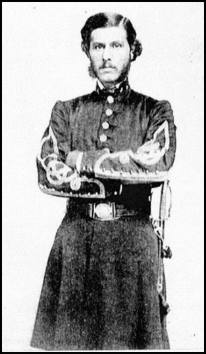Brigadier General Frank Crawford ArmstrongBorn November 22, 1835 Choctaw Agency, Indian Territory Fought First Bull Run/Manassas on Union side Died September 8, 1909 Bar Harbor ME Buried Rock Creek Cemetery Georgetown DC |
|
Brigadier-General Frank C. Armstrong, in 1854, accompanied his stepfather Gen. Persifer Smith, upon an expedition of United States troops into New Mexico. He was then a handsome youth of twenty years, six feet tall, straight as an arrow, and the ideal of a daring young cavalryman. As the part were nearing Eagle Spring a detachment was made under John G. Walker to punish some Indian marauders, and Armstrong was so distinguished in the fight which resulted that he was reported to the war department, and got a lieutenancy of cavalry without the ordinary four years of preparation at West Point. Withdrawing from the United States service in 1861, he accompanied Col. James McIntosh in the march of his force from Arkansas into the Indian country, and participated in the battle of Chustenahlah, in the Cherokee nation, December 26, 1861, in which the power of the Union chief Hopoeithleyohola was broken, serving as a volunteer aide on the staff of Colonel McIntosh. He next, with the rank of lieutenant, became assistant adjutant-general on the staff of Gen. Ben McCulloch, his friend, Col. D. H. Maury, being adjutant-general on the staff of General Van Dorn, commanding. In the famous battle of Elkhorn Tavern, he was with McCulloch until the latter was killed, and afterward, with Lomax and Bradfute and other fellow staff officers, went to the assistance of General Van Dorn, who warmly commended their services in his official report. On March 17th, Van Dorn, in a communication to the war department, strongly urged the promotion of those experienced officers, declaring that if he could have substituted some of them for some of his highest commanders, he could have put the enemy to utter rout. After serving a time as adjutant-general of Steen's Missouri brigade, Armstrong was elected colonel of the Third Louisiana infantry. Van Dorn renewed his recommendation that he be promoted to brigadier general, and after the army had crossed to the east of the Mississippi, Gen. Sterling Price, having the same application of the ability of the gallant young officer, appointed Armstrong to the command of all the cavalry of the army of the West, giving him, with the consent of General Bragg, the rank of acting brigadier general. His energy and ability were soon manifest in the organization and increased efficiency of his command. On July 17th, Bragg about to move to Chattanooga from Tupelo, ordered General Armstrong to advance toward Decatur, Ala., to cover the transfer of the army. With portions of the squadrons and companies of Webb, Barteau, McCulloch, Hill, Sanders, Roddey, and Newsom he attacked the enemy at Courtland, Ala., July 25th, and won a brilliant victory, taking 133 prisoners and gaining possession of the fertile Tennessee valley from Decatur to Tuscumbia. His continued successes brought him the warm congratulations of General Bragg. In August, 1862, he was send with about 2,000 cavalry to make a demonstration in west Tennessee in co-operation with Bragg, and prepatory to Price's advance. He crossed the Hatchie river, passed between Jackson and Bolivar, destroyed brigades and trestles on the Memphis and Charleston railroad, drove the Federals into Bolivar, August 30th, and on his return defeated their infantry, cavalry and artillery at Britton's lane, near Denmark, capturing 213 prisoners and two pieces of artillery. Said General Price: "The highest praise should be awarded to General Armstrong for the prudence, discretion, and good sense with which he conducted this expedition." His cavalry force, the regiments of Wirt Adams and Slemons, did gallant service during the fighting of Price's army at Iuka in September, and on October 3d, 4th and 5th at Corinth and the crossing of the Hatchie, covering the retreat as well as providing a bridge for the transportation of the army. General Maury writes that to Armstrong more than any other officer, Price's army owed its safe retreat from Iuka, and at Corinth, Armstrong found a safe retreat for Van Dorn's broken command. He was promoted to brigadier-general January 30, 1863. Under Van Dorn he was one of the brigade commanders in western Tennessee in March, 1863, and had a conspicuous part in the victory at Thompson's Station on March 25th. His brigade, under his command, captured the Federal garrison at Brentwood, after a spirited fight. On April 10th he was in battle at Franklin, and on June 4th again attacked the Federal garrison there. In the organization of the cavalry corps of the army of Tennessee, following the Kentucky campaign, he commanded a brigade of Forrest's division, consisting of the Third Arkansas, Second Kentucky, First Tennessee, McDonald's battalion and Brady's escort company. Upon the organization of a corps under Forrest, he was put in command of a cavalry division including his brigade and Dibrell's. He rendered important service after the evacuation of Chattanooga, attached to Polk's corps, and on September 20th participated in the battle of Chickamauga in command of his division fighting dismounted. "The charges made by Armstrong's brigade while fighting on foot," said General Forrest, "would be creditable to the best drilled infantry." In command of a division including the brigades of W. Y. C. Humes and C. H. Tyler, he was in the East Tennessee campaign with Longstreet during the winter of 1863-64, in frequent battle, and was commended for gallantry by Gens. Joseph Wheeler and W. T. Martin. Early in February, 1864, he obtained leave of absence from this field with authority to ask for transfer to the command of Gen. S. D. Lee. On March 5th he was ordered to report to Lieutenant-General Polk at Demoplolis, Ala., and was under the orders of Lee, who named him as deserving of promotion to major-general and becoming his own successor in division command. On April 4th he was assigned to the Mississippi brigade of W. H. Jackson's division, consisting of the cavalry regiments of Pinson, Dillon, Starke and Ballentine, which was his command, with some temporary additions, until the close of the war. He accompanied Polk's army to Georgia and served with credit in the campaign from Resaca to Atlanta and Jonesboro (part of the time in command of Jackson's division), Hood's north Georgia campaign, the advance into Tennessee, the campaign against Murfreesboro, and was one of the leaders of the heroic rear guard under Forrest after the disaster at Nashville. During the early months of 1865 he continued in command of his brigade, and was ordered to Selma, Ala., March 23d, where he and his men participated in the gallant defense against the overwhelming forces of Gen. James H. Wilson, on April 2, 1865. At the last he was in command of the Mississippi division of cavalry, with headquarters at Macon.
Source: Evans, Clement, ed. Confederate Military History, Vol. VIII, Clearwater, SC. Eastern Digital Resources. 1998
|
|
||
|
Evans, Clement A. Confederate Military History - Missouri Volume |
$25.00 
|
$15.00 
|
|
Rigdon, John C. The Civil War in Missouri |
$35.00 
| |

|
|
Ordering via EMAIL is easy. Click Here |
Orders may also be sent via U.S. Snail to:
Eastern Digital Resources
PO Box 1451
Clearwater, SC 29822-1451
Tel: (803) 439-2938
You may use this search feature to search either ResearchOnLine or the entire WWW. Google has indexed approximately 22,600 pages on this site.
______________________________



